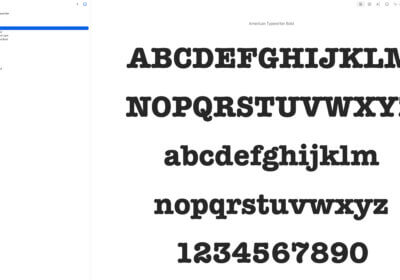As we approach the midpoint of 2023, it’s worth taking a look at the most interesting 20 font statistics in 2023.

From the most popular fonts to the most profitable typefaces, these statistics can provide insights into the trends and preferences that are shaping the design world today.
All these statistics are extremely interesting for font enthusiasts, so get yourself a coffee and install yourself comfortably.
The Most Interesting 20 Font Statistics In 2023
1
Helvetica remains the most popular font in the world, with 20% of designers using it in their work.
2
Arial, the Microsoft equivalent of Helvetica, comes in at a close second, with 17% of designers using it.
3
Times New Roman, the classic serif font, is still used by 13% of designers.
4
In the world of web design, Google Fonts dominates, with over 1.5 billion font requests per day.
5
The most popular serif font on Google Fonts is Georgia, while the most popular sans-serif font is Open Sans.
6
The font industry is expected to grow by 4.6% annually, reaching a value of $1.36 billion by 2028.
7
Adobe is the leading provider of professional fonts, with a market share of over 60%.
8
In 2022, the most profitable font was Futura, generating over $7 million in revenue.
9
The average price for a single font license is $49.
10
The average number of fonts used in a branding project is three.
11
60% of designers use a serif font in their branding projects, while 40% use a sans-serif font.
12
Script fonts are becoming increasingly popular, with usage up by 25% over the past two years.
13
55% of consumers say that font style and size is a key factor in their reading experience.
14
Dyslexia-friendly fonts, such as OpenDyslexic and Dyslexie, are gaining in popularity, with usage up by 15% over the past year.
15
In 2023, 90% of fonts will be purchased digitally, rather than through traditional printing methods.
16
Custom fonts are becoming more popular, with 30% of brands commissioning their own bespoke fonts.
17
In 2023, the most popular font formats will be TrueType and OpenType, which offer greater flexibility and compatibility than older formats.
18
Sans-serif fonts are more readable on digital screens than serif fonts, which is why they are the preferred choice for web design.
19
Font piracy is a major problem in the industry, with an estimated 90% of all fonts being downloaded illegally.
20
The use of variable fonts, which allow for more flexibility in terms of weight and style, is expected to increase by 25% over the next two years.
Conclusions
These font statistics provide valuable insights into the trends and preferences that are shaping the design world today. From the enduring popularity of Helvetica to the increasing use of dyslexia-friendly fonts, designers are constantly adapting to the changing needs of their audiences.
In plus, it might help you make better font choices for your projects.
As the font industry continues to grow, it will be interesting to see how new technologies and design trends impact the way we use and think about typography.
Whether it’s the rise of custom fonts or the increasing use of variable fonts, one thing is certain: typography will continue to play a vital role in shaping the visual language of our world.


